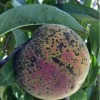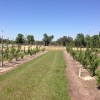 Mosaic disease of St. Augustinegrass was first reported in the 1960s in sugarcane producing areas of Palm Beach County, Florida. In the 10 years prior to 2013, less than 5 samples with mild symptoms were brought to the attention of the extension turfgrass pathologist. But in September 2013, an outbreak of the disease occurred in Pinellas County. Leaf symptoms included mosaic, but turned necrotic and the severe dieback that completely killed some infected lawns. In September 2014, lawns infected in 2013 and new lawns started dying in both Pinellas and Palm Beach Counties. Despite the similarity of symptoms to another St. Augustinegrass decline (SAD), as of November 2014, all samples have tested negative for SAD, and positive for presence of Sugarcane Mosaic Virus. This 3-page fact sheet was written by Phil Harmon, and published by the UF Department of Plant Pathology, November 2014.
Mosaic disease of St. Augustinegrass was first reported in the 1960s in sugarcane producing areas of Palm Beach County, Florida. In the 10 years prior to 2013, less than 5 samples with mild symptoms were brought to the attention of the extension turfgrass pathologist. But in September 2013, an outbreak of the disease occurred in Pinellas County. Leaf symptoms included mosaic, but turned necrotic and the severe dieback that completely killed some infected lawns. In September 2014, lawns infected in 2013 and new lawns started dying in both Pinellas and Palm Beach Counties. Despite the similarity of symptoms to another St. Augustinegrass decline (SAD), as of November 2014, all samples have tested negative for SAD, and positive for presence of Sugarcane Mosaic Virus. This 3-page fact sheet was written by Phil Harmon, and published by the UF Department of Plant Pathology, November 2014.
http://edis.ifas.ufl.edu/pp313
Tag: Philip F. Harmon
Peach Scab
 Peach scab is a disease caused by the fungus Cladosporium carpophilum. The pathogen can infect other fruits and nuts within the Prunus species, like almonds, apricots, nectarines, and plums. Peach scab is common during periods of humid weather because rain splashes the conidia (asexual spores) from the fungus between leaves, twigs, and fruit in the tree canopy, which spreads the disease. This 6-page fact sheet was written by Daniel Mancero-Castillo, Mercy Olmstead, and Phillip Harmon, and published by the UF Department of Horticultural Sciences, July 2014.
Peach scab is a disease caused by the fungus Cladosporium carpophilum. The pathogen can infect other fruits and nuts within the Prunus species, like almonds, apricots, nectarines, and plums. Peach scab is common during periods of humid weather because rain splashes the conidia (asexual spores) from the fungus between leaves, twigs, and fruit in the tree canopy, which spreads the disease. This 6-page fact sheet was written by Daniel Mancero-Castillo, Mercy Olmstead, and Phillip Harmon, and published by the UF Department of Horticultural Sciences, July 2014.
http://edis.ifas.ufl.edu/hs1249
Florida Subtropical Peaches: Production Practices
 Subtropical peach production includes many practices, such as site selection, orchard design, and disease, weed, and insect management through to harvest. Florida’s subtropical climate allows growers to harvest their crops early, but it creates challenges for the long postharvest growing season. This 14-page fact sheet covers the breadth of topics related to subtropical peach production, including a monthly timeline of recommended practices. Written by M. Olmstead, J. Chaparro, J. G. Williamson, R. Rouse, R. Mizell, P. Harmon, and J. Ferguson, and published by the UF Department of Horticultural Sciences, August 2013.
Subtropical peach production includes many practices, such as site selection, orchard design, and disease, weed, and insect management through to harvest. Florida’s subtropical climate allows growers to harvest their crops early, but it creates challenges for the long postharvest growing season. This 14-page fact sheet covers the breadth of topics related to subtropical peach production, including a monthly timeline of recommended practices. Written by M. Olmstead, J. Chaparro, J. G. Williamson, R. Rouse, R. Mizell, P. Harmon, and J. Ferguson, and published by the UF Department of Horticultural Sciences, August 2013.
http://edis.ifas.ufl.edu/hs348
Professional Disease Management Guide for Ornamental Plants (PP202/PP123)
 Florida’s warm, humid environment is a gardener’s paradise and a great location for ornamental plant producers to grow numerous plant species — but these conditions also are suitable for the development of a wide variety of plant pathogens and insects that can spread them. Florida is also a major port of entry for the international trade of ornamental plants, which carries the risk of introducing exotic invasive pathogens, so growers are required to follow certain phytosanitory regulations. These challenges require growers to develop the most efficient production plans possible, incorporating as many tactics as they can to maximize plant health and minimize opportunities for pest and disease outbreaks—a concept known as integrated pest management (IPM). This 16-page fact sheet is intended to be used by growers, landscape professionals, and other pest control operators as a reference for managing ornamental plant diseases. Written by P. F. Harmon and S. D. Bledsoe, and published by the UF Department of Plant Pathology, June 2012.
Florida’s warm, humid environment is a gardener’s paradise and a great location for ornamental plant producers to grow numerous plant species — but these conditions also are suitable for the development of a wide variety of plant pathogens and insects that can spread them. Florida is also a major port of entry for the international trade of ornamental plants, which carries the risk of introducing exotic invasive pathogens, so growers are required to follow certain phytosanitory regulations. These challenges require growers to develop the most efficient production plans possible, incorporating as many tactics as they can to maximize plant health and minimize opportunities for pest and disease outbreaks—a concept known as integrated pest management (IPM). This 16-page fact sheet is intended to be used by growers, landscape professionals, and other pest control operators as a reference for managing ornamental plant diseases. Written by P. F. Harmon and S. D. Bledsoe, and published by the UF Department of Plant Pathology, June 2012.
http://edis.ifas.ufl.edu/pp123
Sudden Oak Death and Ramorum Blight (PP197/PP118)
Sudden oak death and ramorum blight are relatively new diseases capable of causing a range of symptoms, from leaf spots to plant death, on many woody hosts. Because these diseases are new, much about the pathogen, host range, and disease epidemiology is unknown. Currently, neither sudden oak death nor ramorum blight is established in Florida, but state agencies and university educators continue to work together to monitor for these diseases. This revised 4-page fact sheet describes the causal agent and gephgraphical distribution, host range, disease symptoms, and control options. Written by Phil Harmon and Carrie Harmon, and published by the UF Department of Plant Pathology, March 2011.
http://edis.ifas.ufl.edu/pp118
Homeowner’s Guide to Fungicides for Lawn and Landscape Disease Management (PP233/PP154)
Homeowners are often discouraged from using fungicide products to manage diseases of the lawn and landscape, but many fungicides are packaged for and marketed to homeowners. This 5-page fact sheet provides guidance in using fungicides appropriately to manage some lawn and landscape diseases. Written by Phil Harmon, Aaron Palmateer, Rachel Ribbeck, and published by the UF Department of Plant Pathology, March 2011.
http://edis.ifas.ufl.edu/pp154
Take-all Root Rot (SSPLP16/LH079)
Take-all root rot, or Bermudagrass decline, is a root rot disease triggered by high rainfall or stress and manifesting as irregular yellow or light green patches two to three weekds after the pathogen has been active in the roots. This 3-page fact sheet was written by M. L. Elliott and P. F. Harmon and published by the UF Department of Plant Pathology, February 2011.
http://edis.ifas.ufl.edu/lh079
Brown Patch (SSPLP5/LH044)
Brown patch, large patch, or Rhizoctonia blight is a fungal disease observed November through May that infects the leaf area closest to the soil, eventually killing the leaf. This 3-page fact sheet was written by M. L. Elliott and P. F. Harmon and published by the UF Department of Plant Pathology, February 2011.
http://edis.ifas.ufl.edu/lh044
Turfgrass Disease Management (SSPLP14/LH040)
Turfgrass diseases are underappreciated because the biological organisms (plant pathogens) causing the problems are rarely observed. Fortunately, grasses maintained using proper cultural practices (water, mowing, and fertility) are not as likely to become diseased or be as severely damaged as grasses that do not receive proper care. This 11-page fact sheet discusses turfgrass diseases, their causal agents, diagnosis, and management. Written by M. L. Elliott and P. F. Harmon and published by the UF Department of Plant Pathology, February 2011.
http://edis.ifas.ufl.edu/lh040
Cercospora Leaf Spot (SSPLP57/LH082)
Cercospora leaf spot is a fungal disease of St. Augustinegrass observed during periods of frequent rainfall. This revised 2-page fact sheet was written by M. L. Elliott and P. F. Harmon, and published by the UF Department of Plant Pathology, February 2011.
http://edis.ifas.ufl.edu/lh082
Rust (SSPLP12/LH051)
Rust is a fungal disease that occurs in cool weather causing yellow specks enlarging to spots with orange pustules in St. Augustinegrass and zoysiagrass. This revised 2-page fact sheet was written by M. L. Elliott and P. F. Harmon, and published by the UF Department of Plant Pathology, February 2011.
http://edis.ifas.ufl.edu/lh051
Pythium Root Rot (SSPLP11/LH050)
This fungal root disease affecting all warm-season turfgrasses is associated with wet soil conditions causes nonspecific decline in turf quality. This revised 2-page fact sheet was written by M. L. Elliott and P. F. Harmon, and published by the UF Department of Plant Pathology, February 2011.
http://edis.ifas.ufl.edu/lh050
Helminthosporium Leaf Spot (SSPLP9/LH048)
This fungal disease is most serious on bermudagrass and acts over a wide range of temperatures. This 2-page fact sheet was written by M. L. Elliott and P. F. Harmon, and published by the UF Department of Plant Pathology, February 2011.
http://edis.ifas.ufl.edu/lh048
Gray Leaf Spot (SSPLP8/LH047)
This disease affects primarily St. Augustinegrass, but also centipedegrass. It is most often observed from late spring to early fall, especially during prolonged periods of rainfall. This revised 2-page fact sheet was written by M. L. Elliott and P. F. Harmon, and published by the UF Department of Plant Pathology, February 2011.
http://edis.ifas.ufl.edu/lh047
Fairy Rings (SSPLP7/LH046)
Fairy rings, especially the mushrooms, are most commonly observed during the summer months, when Florida receives the majority of its rainfall. This revised 2-page fact sheet with identification and control information was written by M. L. Elliott and P. F. Harmon, and published by the UF Department of Plant Pathology, February 2011.
http://edis.ifas.ufl.edu/lh046
Anthracnose (SSPLP56/LH043)
Identify and control for this disease that often appears as reddish-brown spots surrounded by a narrow yellow halo, primarily in centipedegrass. This revised 2-page fact sheet was written by M. L. Elliott and P. F. Harmon, and published by the UF Department of Plant Pathology, February 2011.
http://edis.ifas.ufl.edu/lh043
PP256/PP172 Rusts on Ornamentals in Florida
PP-256, a 6-page illustrated fact sheet by Philip F. Harmon, Carrie L. Harmon, Aaron J. Palmateer, Stephen H. Brown, presents information on four representative rust diseases of ornamentals, including gladiolus rust, daylily rust, frangipani rust, and guava rust. Includes references. Published by the UF Department of Plant Pathology, May 2009.
http://edis.ifas.ufl.edu/PP172